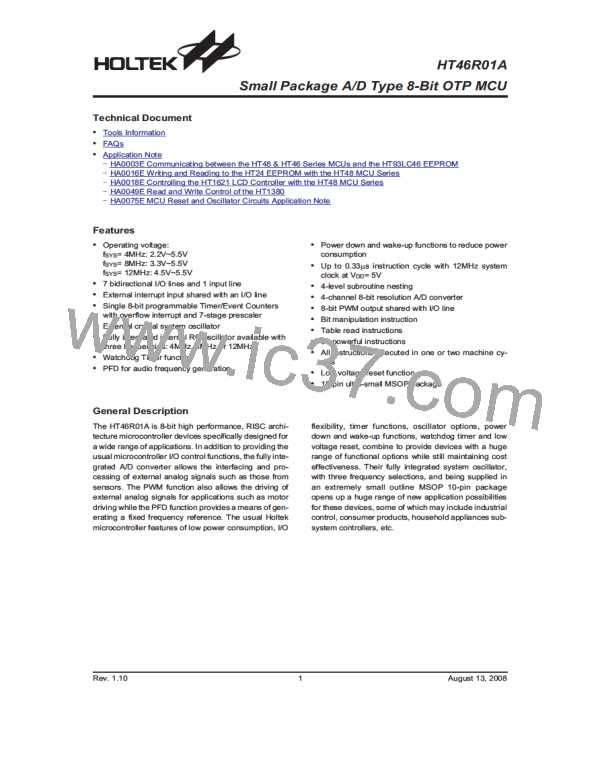HT46R01A
Pin Description
Configuration
Options
Pin Name
I/O
Description
Bidirectional single line I/O. The pin can be setup as a wake-up input using
the wake-up register. Software instructions determine if the pin is a CMOS
output or a Schmitt Trigger input. A pull-high resistor can be connected using
the pull-high register. PA0 is pin-shared with the AN0 input pin. The A/D input
function is selected via software instructions. If selected as an A/D input, the
I/O function and pull-high resistor functions are disabled automatically.
PA0/AN0
I/O
¾
¾
Bidirectional single line I/O. The pin can be setup as a wake-up input using
the wake-up register. Software instructions determine if the pin is a CMOS
output or a Schmitt Trigger input. A pull-high resistor can be connected using
the pull-high register. PA1 is pin-shared with the PFD output and the AN1 in-
put pin. The A/D input function is selected via software instructions. If selected
as an A/D input, the I/O function, PFD output and pull-high resistor functions
are disabled automatically. If the A/D function is not selected the PFD output
or I/O function selection is chosen via a bit in the CRTL0 register.
PA1/PFD/AN1
I/O
Bidirectional single line I/O. The pin can be setup as a wake-up input using
the wake-up register. Software instructions determine if the pin is a CMOS
output or a Schmitt Trigger input. A pull-high resistor can be connected us-
ing the pull-high register. PA2 is pin-shared with the TMR0 input and the
AN2 input pin. The A/D input function is selected via software instructions. If
selected as an A/D input, the I/O function, timer input and pull-high resistor
functions are disabled automatically.
PA2/TMR0/AN2 I/O
¾
Bidirectional single line I/O. The pin can be setup as a wake-up input using
the wake-up register. Software instructions determine if the pin is a CMOS
output or a Schmitt Trigger input. A pull-high resistor can be connected us-
ing the pull-high register. PA3 is pin-shared with the INT input and the AN3
input pin. The A/D input function is selected via software instructions. If se-
lected as an A/D input, the I/O function, external interrupt input and pull-high
resistor functions are disabled automatically.
PA3/INT/AN3
I/O
I/O
¾
¾
Bidirectional single line I/O. The pin can be setup as a wake-up input using
the wake-up register. Software instructions determine if the pin is a CMOS
output or a Schmitt Trigger input. A pull-high resistor can be connected us-
ing the pull-high register. PA4 is pin-shared with the PWM output pin. The
PWM output or I/O function selection is chosen via a bit in CTRL0 register.
PA4/PWM
Bidirectional 2-line I/O. The pins can be setup as wake-up inputs using the
wake-up register. Software instructions determine if the pins are CMOS out-
puts or Schmitt Trigger inputs. Pull-high resistors can be connected using
the pull-high register. Configuration options determine if the pins are to be
used as oscillator pins or I/O pins. Configuration options also determine
which oscillator mode is selected. The four oscillator modes are:
1. Internal RC OSC: both pins configured as I/Os.
PA6/OSC1
PA5/OSC2
RC, Crystal,
RTC or I/O
I/O
2. External crystal OSC: both pins configured as OSC1/OSC2.
3. Internal RC + RTC OSC: both pins configured as OSC2, OSC1.
4. External RC OSC+PA5: PA6 configured as OSC1 pin, PA5 configured
as I/O.
If the internal RC OSC is selected, the frequency will be fixed at either
4MHz, 8MHz or 12MHz, dependent upon which device is chosen.
Active low Schmitt trigger reset input or PA7 input. A configuration option
PA7/RES
I
PA7 or RES determines which function is selected. PA7 has a wake-up function but does
not have a pull-high function.
VDD
VSS
Positive power supply
¾
¾
¾
¾
Negative power supply, ground
Note: Each pin on PA except PA7 can be selected to have a pull-high resistor.
Rev. 1.10
3
August 13, 2008

 HOLTIC [ HOLT INTEGRATED CIRCUITS ]
HOLTIC [ HOLT INTEGRATED CIRCUITS ]